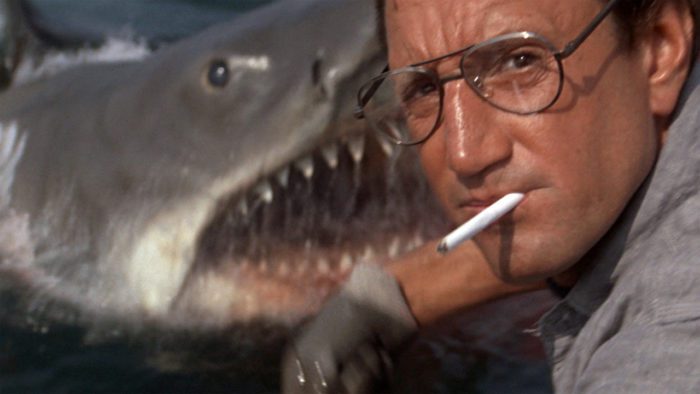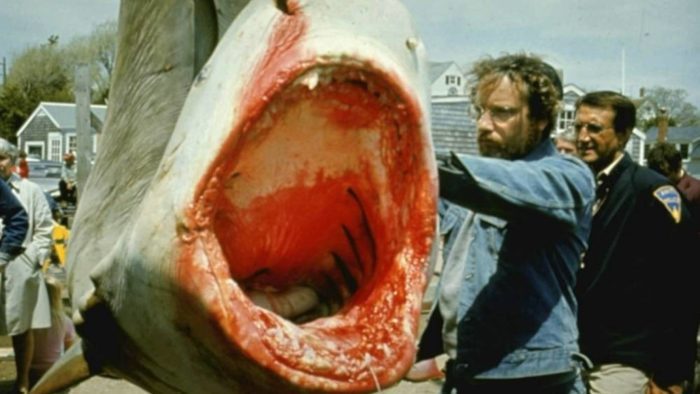Stephen Spielberg’s Jaws has been inspiring filmmakers since its release in 1975. The film is based on a novel by New Jersey-based writer Peter Benchley. For many years, it’s been said that Benchley was inspired by a series of shark attacks that occurred in 1916 along the Jersey Shore, killing four people and injuring one. However, other sources say it didn’t.
Fiction vs. Fact
In both the movie and in real life, a few swimmers are killed by sharks in beach resort towns. Consequently, the town offers a reward to anyone who can catch the shark, drawing in people from miles around. Both the real-life events and the movie reportedly sparked a shark hunting craze and damaged sharks’ reputation for many years to come.
While the stories are the same, according to Benchley’s obituary, published in The Guardian, the 1916 Jersey Shore attacks may not have served as an inspiration for Jaws. At the time that Benchley wrote Jaws, he was a struggling freelance writer trying to support a family. He had had an idea swimming around in the back of his mind for 10 years. Benchley read a magazine article in 1964 about a fisherman who caught a 2,064 kg (4,550 lb.) great white shark off Long Island. Benchley also wrote a piece about life in a beach resort town. This led him to think about what would happen if a massive great white terrorized a beach resort. As he wrote the novel, Benchley drew on his childhood memories of fishing on Nantucket.
In the film, the 1916 shark attacks are mentioned in a scene during which Chief Brody and Matt Hooper confront Mayor Larry Vaughn about closing the beaches. However, it’s also important to note that the screenplay was loosely based on Benchley’s novel. Benchley originally wrote the screenplay, which was scrapped and rewritten. According to a 2020 Screen Rant article, “10 Things You Didn’t Know About the Making of Jaws,” Spielberg reportedly didn’t like Benchley’s script, so he brought in screenwriter Carl Gottlieb, who rewrote the script with John Milius, who is known for his work on the movie Dirty Harry. However, Screen Rant points out that Gottlieb rewrote a majority of the script while filming. Many of the scenes were improvised. Every night during filming, Spielberg, the writers, and the actors scheduled to shoot the following day met over dinner to discuss an upcoming scene. Much of what the actors came up with was used in the scenes. So, anyone could’ve provided a reference to the 1916 shark attacks.
Although it may not have inspired Jaws, the story of the 1916 Jersey Shore shark attacks lives on and continues to fascinate us. Whether it inspired Jaws or not, the truth can sometimes be just as or more interesting than fiction.

The First Attack
It all started on July 1, 1916, when 28-year-old Philadelphia resident Charles Epting Vansant decided to go for a swim before dinner. Vansant and his family were on vacation in Beach Haven, staying at the Engleside Hotel. Vansant went into the water with a dog that had been playing on the beach. Witnesses said that Vansant began yelling shortly after wading into the water. Bathers nearby thought he was calling to the dog. In reality, Vansant cried out because a shark had bitten him.
Lifeguard Alexander Ott and a beach-goer, Sheridan Taylor, jumped into the water. The shark reportedly followed them to shore as they pulled Vansant from the water. According to “July Attacks of the New Jersey ‘Jaws’,” on WeirdNJ.com, the shark took the flesh off of Vansant’s left thigh. He died on the manager’s desk at the hotel at 6:45 p.m.
According to a 2018 article on History.com, “The Real-Life ‘Jaws’ That Terrorized the Jersey Shore,” a physician determined that Vansant was attacked by a shark. The History.com article cites an earlier article that appeared in Philadelphia’s Public Ledger, “Bathers Need Have No Fear of Sharks.” The article reported that the attack was a “freak accident” and that the shark was trying to attack the dog.
The Second Victim
Five days after Vansant bled to death from a shark bite, Charles Bruder went for a swim in the town of Spring Lake. Spring Lake is 45 miles north of Beach Haven. Bruder, 27, an employee at the Essex and Sussex Hotel, went for his usual lunchtime swim. Bruder swam 130 yards from shore before a shark bit off parts of both legs—above the knee on the left and below the knee on the right. Lifeguards jumped in and pulled Bruder to shore. However, it was too late.
In Bruder’s case, an assistant curator at New York’s American Museum of Natural History examined his body and said that Bruder was bitten by a killer whale. However, others thought that it was a giant tuna or sea turtle. More than one source reported that there was even a conspiracy theory that the Germans trained sharks to follow U-Boats and attack American bathers. After Bruder’s attack, some safety measures were put in place along the Jersey Shore, including boat patrols and protective nets.

Matawan Creek Attacks
According to WeirdNJ.com, Thomas Cattrell, a retired fishing boat captain, saw the shadow of what he believed to be a shark heading toward the old Matawan docks. He went into Matawan and warned everyone. No one listened even though the reports of the attacks on Vansant and Bruder had been reported in the newspapers. No one believed that a shark would go into a small body of fresh water. However, another attack occurred 25 miles north in Matawan Creek.
It was 96 degrees on July 12th, when 11-year-old Lester Stillwell went for a swim with some friends along Matawan Creek. The boys in the group all worked at a basket weaving factory. Their boss allowed them to take a break on that hot day to go for a swim. Lester swam a mile out into the creek, near where it empties into Raritan Bay. Witnesses reportedly heard Lester scream as a shark pulled him under the water by his stomach.
The boys ran into town, screaming for help along Main Street. Stanley Fisher, 24, a tailor, was one of many townspeople who rushed to the scene. He searched the water for Lester on a rowboat but couldn’t find him. Lester’s parents watched from the banks of the creek as Fisher dove into the water. Fisher found Lester’s body in the water. However, at the same time, the shark reappeared and bit into Fisher’s right leg. Fisher’s neighbors helped get him to shore and tried to bandage his wounds. Fisher died hours later at Monmouth Hospital in Long Branch, NJ.
One hour later, Joseph Dunn, 12, was attacked. Dunn survived but lost his leg. He was the final victim.
Theories from a Shark Expert
In a 2012 article for Smithsonianmag.com, “The Shark Attacks That Were the Inspiration for Jaws,” writer Megan Gambino spoke to George Burgess. An ichthyologist, Burgess was curator of the International Shark Attack File. The archive contains every shark attack from the 16th century to the present. Burgess told Gambino that he and his team investigate attacks worldwide “much like a detective would investigate a crime.” The article notes that “They interview the victim and any witnesses, collect medical records, and study photographs of the wounds to determine the size and perhaps the species of shark responsible.”
Burgess said that not much was known about sharks at the time and that there were a lot of misconceptions and negative portrayals of sharks in the media. Not much money was put into the study of sharks. According to Burgess, funds were reserved to study animals that were considered most important to the economy, such as salmon, tuna, and cod. Sharks were at the bottom of the priority list simply because they were unmarketable. However, the fact that they ate all of the aforementioned valuable fish made them a pest that people wanted to be rid of. For these reasons, there was very little time put into shark research until the 1990s.
Burgess said that the shark in the Jersey Shore attacks probably came so close to shore because its food supply was low. He also said that the shark could have been deformed in some way or injured. Burgess said, “…lions or elephants, with injuries to their feet or a rotten tooth, have sometimes been implicated in attacks on humans because they were feeling pain from these things.” Burgess points out that, although rare, the same thing could happen with a shark. “We don’t have very many instances in all of our studies on sharks where we can attribute multiple attacks to a single individual, the so-called rogue shark,” Burgess added.

Aftermath
After the attacks, Burgess said that fences were put up around the beaches. Also, like in the movie Jaws, some shore communities offered rewards to people willing to catch the shark. With a monetary reward on the table, many decided to embark on a shark hunt. It got to a point where a local newspaper declared shark fishing a new sport.
The last newspaper story regarding the attacks was that an eight-and-a-half-foot great white shark was caught near where the attacks occurred. When the fish was autopsied, it allegedly contained the remains of two Matawan Creek victims. The shark was put on display at a shop in New York. For a fee, the curious could view the fish. The shop owner reportedly made a good sum of money off the exhibit.
However, Burgess said that this information is difficult to confirm. The pictures of the shark were unclear and prevented them from being able to determine what type of shark it was. Furthermore, there was no official coroner’s report to confirm that the remains of the victims were in the shark’s stomach.
According to the Matawan Historical Society’s website, Lester Stillwell and Stanley Fisher had separate funeral services, but both are interred at Rosehill Cemetery in Matawan.
A 2015 NJ.com article, “The 1916 shark attacks: Matawan, N.J.’s 100-year struggle with a bloody legacy,” reported that a memorial was unveiled for the 100th anniversary of the attacks. The website Own-Two-Hand.com has a page, “Site of the New Jersey Shark Attacks of 1916,” for the memorial in Matawan dedicated to Lester Stillwell and Stanley Fisher in the town’s Memorial Park. The YouTube video, “The 1916 New Jersey Shark Attacks Location,” by Mobile Instinct gives a tour of the area and a visit to both Lester Stillwell’s and Stanley Fisher’s graves. It’s interesting to note that at some point, someone painted a Jaws-style mural at the creek with “1916” spraypainted next to it.
While the events of 1916 parallel those in the classic film Jaws, they may not have served as Benchley’s inspiration. However, the movie presents a situation more frightening than any human slasher. Being viewed as potential prey by any animal in its natural habitat is just as, if not more, frightening than a knife-wielding slasher that you could possibly outrun. Unfortunately, both the 1916 attacks and the movie Jaws gave sharks a bad reputation for a long time. However, later in life, Benchley regretted that his novel tarnished sharks’ reputation and became a shark conservationist. Also, without Jaws, would there be a Shark Week, dedicated to educating the public about real-life shark behavior?



